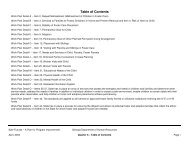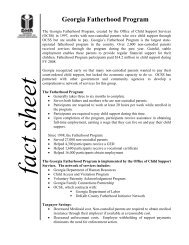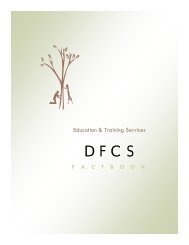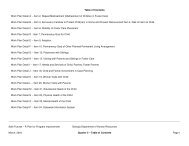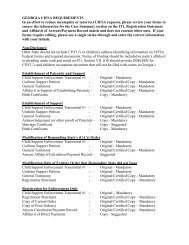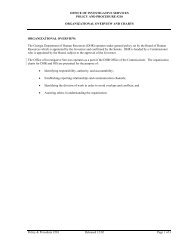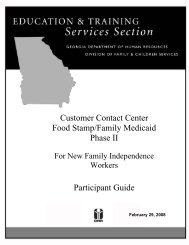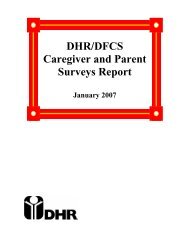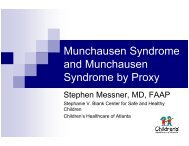an overview georgia program improvement plan - Department of ...
an overview georgia program improvement plan - Department of ...
an overview georgia program improvement plan - Department of ...
You also want an ePaper? Increase the reach of your titles
YUMPU automatically turns print PDFs into web optimized ePapers that Google loves.
6 th Quarter Report: The CPRS Basic Training <strong>an</strong>d the CPRS adv<strong>an</strong>ced training both have a Visitation screen that is designed to document<br />
the visitation pl<strong>an</strong> for children with their parents. In SFY 2003, 1200 workers <strong>an</strong>d their supervisors were trained in either Basic or Adv<strong>an</strong>ced<br />
training. In SFY2004, 377 additional workers <strong>an</strong>d supervisors were trained in Basic, Adv<strong>an</strong>ced or Supervisory training. In each session,<br />
visitation <strong>of</strong> parents <strong>an</strong>d children was stressed <strong>an</strong>d staff were instructed on how to document the visitation pl<strong>an</strong> in the Case Pl<strong>an</strong> Reporting<br />
System. New Worker Training includes training on documenting the visitation pl<strong>an</strong> in the CPRS.<br />
6 th Quarter Federal Response: Are you going to evaluate visits between parents <strong>an</strong>d children <strong>an</strong>d the location <strong>of</strong> visits by June 2004?<br />
H5: Continue to report progress<br />
7 th Quarter Reply: The Action Step <strong>an</strong>d benchmark speaks to documenting the occurrence <strong>an</strong>d location <strong>of</strong> visits in the case pl<strong>an</strong>. A<br />
cumulative Qualitative Case Review for the 10 month period 10/03 – 06/04 shows that in 60 relev<strong>an</strong>t cases, 51 cases (85.0%)<br />
indicated that visitation took place. These visits took place in a variety <strong>of</strong> venues that included agency <strong>of</strong>fices, the parents' home <strong>an</strong>d<br />
were supervised by agency staff or relatives. Other visits took place in restaur<strong>an</strong>ts or treatment facilities. The State recognizes that we<br />
are currently 5% behind in goal achievement <strong>of</strong> this action step. However, the baseline from the ACF Final Report was 66.6%, the<br />
85.0% indicates a signific<strong>an</strong>t increase. Training efforts will continue to reinforce the import<strong>an</strong>ce <strong>of</strong> preserving family connections <strong>an</strong>d<br />
emphasize documentation as the appropriate measure <strong>of</strong> success.<br />
AFCARS Data Frequency Report for Foster Children (10/01/2003 - 03/31/2004) reports a total number <strong>of</strong> 19, 426 children receiving foster<br />
care service during this time period. There are a total <strong>of</strong> 12,378 visitation pl<strong>an</strong>s documented in CPRS. The number <strong>of</strong> case pl<strong>an</strong>s in CPRS is<br />
exaggerated due to several factors. During the migration <strong>of</strong> pl<strong>an</strong>s from the original CPRS to CPRSv2, duplicate cases were created. The<br />
counties were not aware that they needed to close the original pl<strong>an</strong>, so the duplicate pl<strong>an</strong>s remain. Other pl<strong>an</strong>s should have been closed when<br />
their case was closed. The division is now providing training to supervisors on how to identify pl<strong>an</strong>s that need to be closed <strong>an</strong>d how to close<br />
them. Additionally, supervisors <strong>an</strong>d workers are receiving training on how to create a new pl<strong>an</strong> <strong>an</strong>d review existing pl<strong>an</strong>s. The developer for<br />
the system will review the system for “junk pl<strong>an</strong>s” <strong>an</strong>d delete as appropriate. In addition, even though the State has m<strong>an</strong>dated CPRS usage it<br />
is questionable that data input is occurring, as it should. To date the State has been not been able to fund the additional staff resources needed<br />
to monitor staff input. Another factor impacting Georgia’s challenge with capturing <strong>an</strong>d evaluating this information via CPRS is that even<br />
though the case pl<strong>an</strong>s may document the requirement for visitation, all the cases may not adequately document each time <strong>an</strong>d location a visit<br />
occurred, nor whether the occurrence <strong>an</strong>d quality <strong>of</strong> visits is in compli<strong>an</strong>ce with the court order. Thus far, the QCRs seem to be the better<br />
approach to measure whether the visits are occurring <strong>an</strong>d evaluating the quality <strong>of</strong> the visits.<br />
The CPRS Basic Training <strong>an</strong>d the CPRS Adv<strong>an</strong>ced Training both have a component that discusses visitation. Woven throughout the<br />
training documents are references to <strong>an</strong>d instructions on how to input <strong>an</strong>d retrieve information pertaining to children in placement.<br />
This content includes specific references to efforts to assure sibling visitation <strong>an</strong>d documentation <strong>of</strong> the visits.<br />
7 th Quarter DOCUMENTATION:<br />
Safe Futures – A Pl<strong>an</strong> for Program Improvement<br />
Georgia <strong>Department</strong> <strong>of</strong> Hum<strong>an</strong> Resources<br />
November, 2004 Quarter 8 – Work Pl<strong>an</strong> H Page 2




